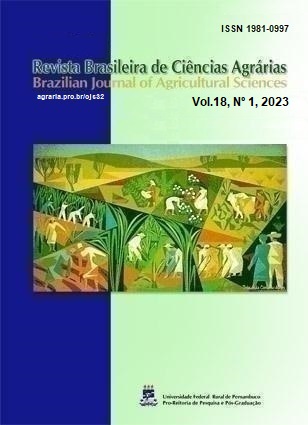Composição química e potencial energético de espécies lenhosas em floresta seca: subsídios para o manejo florestal sustentável
DOI:
https://doi.org/10.5039/agraria.v18i1a2868Palavras-chave:
biomassa, Caatinga, dimensões, espécies nativas, poder calorífico, semiárido brasileiroResumo
A demanda de energia, especialmente nos países em desenvolvimento, é parcialmente suprida por lenha e carvão vegetal de florestas naturais. No entanto, nem sempre existem estudos prévios de qualidade energética, com implicações para o manejo florestal. O estudo objetivou caracterizar o potencial energético da madeira de seis espécies lenhosas da Caatinga e a influência da classe de circunferência em suas propriedades químicas e potencial energético para subsidiar o manejo florestal. Foram estudadas Anadenanthera colubrina var. cebil (Angico), Cenostigma bracteosum (Catingueira), Cnidoscolus quercifolius (Faveleira), Mimosa ophthalmocentra (Jurema branca), Mimosa tenuiflora (Jurema preta) e Aspidosperma pyrifolium (Pereiro) procedentes de uma área de Floresta Seca (Caatinga) em Floresta, estado de Pernambuco, Brasil. Cada espécie teve três indivíduos amostrados em cinco classes de circunferência (I a V) a 1,30 m do solo. Avaliaram-se os teores de carbono, hidrogênio, nitrogênio, lignina insolúvel e cinzas, bem como maiores e menores valores caloríficos, densidades aparente e energética e produção de energia. Na análise estatística se considerou um delineamento inteiramente casualizado em arranjo fatorial (espécies x classes de circunferência), com três repetições, e comparação de médias (Tukey, p < 0,05). Também foi realizada uma análise de agrupamento visando análise conjunta das variáveis. Os resultados mostraram que as biomassas de M. ophthalmocentra e M. tenuiflora apresentam as maiores densidades energéticas e quantidades de energia por unidade de massa. C. quercifolius e A. pyrifolium foram inferiores quando comparados às demais espécies. Além disso, M. ophthalmocentra, M. tenuiflora, A. colubrina e C. bracteosum se destacaram pela geração de energia. As classes IV e V podem ser indicadas como biomassa para combustão, enquanto a classe I apresenta desvantagens, causado pelo maior teor de nitrogênio e menores valores caloríficos superior e inferior.
Downloads
Downloads
Publicado
Como Citar
Edição
Seção
Licença

Este trabalho está licenciado sob uma licença Creative Commons Attribution 4.0 International License.


